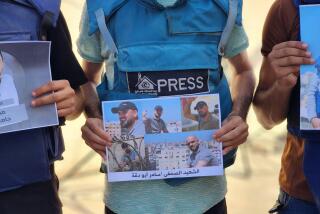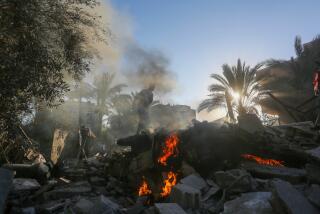Media: A Third Force in Middle East Fight
JERUSALEM — Death with dignity isn’t easy to attain in the harsh and jarring conflict between Israelis and Palestinians.
The front page of the Jerusalem Post carried a gruesome--and inflammatory--three-column picture of the body of Tirza Porat, the 15-year-old Israeli girl who died under confusing circumstances Wednesday in a village near the West Bank city of Nablus. A story on an inside page described her death in appalling detail.
At the public ceremony in her settlement before the funeral procession Thursday, her cloth-covered body was removed from the van/hearse on a stretcher, and TV minicams and still photographers were allowed to close in like predators.
After the speeches, when her body was returned to the van, two still photographers leaned into the vehicle for better close-ups of the covered dead girl.
It was an ugly scene.
There are many of them these days with a reported 1,200 members of the news media--most relatively recent arrivals--patrolling the occupied territories in pursuit of something hot to record.
Sometimes their presence is fortuitous, as with the veteran CBS camera crew reported to have bravely assisted other seemingly endangered Israeli teen-agers during the incident that took the life of Tirza Porat.
Other times. . . .
“On the West Bank, there are so many journalists in such a small area that it creates a problem,” says Edward Bianco, a veteran Israeli cameraman for ABC here. “Sometimes we find ourselves larger than the number of demonstrators.”
It was Bianco (he’s known by his French nickname of Dou Dou) who was the first member of the media to reach the Israeli soldier who was fatally shot in Bethlehem last month.
Although he was accused by a government member of not doing enough to help the fallen soldier, Dou Dou insists that he believed the dying reservist was being adequately tended to by an Israeli civilian. So, after sending his soundman to phone for help, he continued to tape, mostly from afar with a zoom lens.
As it turns out, Dou Dou himself is an accuser. He charges still photographers in Bethlehem with outrageous behavior in hovering over the soldier like vultures, as the civilian worked on him and a seemingly panicky fellow soldier repeatedly shot his rifle into the air trying to attract attention.
Dou Dou allowed me to see his raw footage of the incident, most of which was not in the ABC account.
In the unedited version, while Dou Dou is still taping from a distance, six still photographers gradually appear from nowhere, some of them edging in as close as a foot away from the soldier’s bloody head, crouching and taking their close-ups as the civilian bends over the dying man.
It’s not in his footage, but Dou Dou said that one of the photographers even held a light meter to the soldier’s head. That was going too far. “We need some dignity,” Dou Dou said.
There wasn’t any in a TV story that CNN correspondent Mike Greenspan cites as an example of vulgar reporting.
Greenspan, who wouldn’t divulge the name of the offending reporter, said the account featured a baseball analogy to narrate pictures of stone throwing by Palestinians and clubbing of Palestinian demonstrators by Israeli soldiers:
“Once again, the Palestinians were on the mound and the Israelis were at bat.”
Very, very bad.
On the other hand, it’s not a very dignified conflict.
The Israeli government has been justifiably criticized for imposing sporadic censorship on the media and hinting at total exclusion.
Army commanders can unilaterally bar the press from any area. And there was the virtual banning of the media from the occupied territories for three days recently, during which only a few pool reporters, escorted by the army, were allowed in.
“That moved them closer to South Africa,” said CNN Bureau Chief Robert Wiener, using an analogy that outrages many Israelis and American Jews.
There were fears that the three-day ban was a precedent-setting measure that the government would repeat when it sees fit, especially since the picture-reliant American TV networks reluctantly went along with the pool arrangement that other Western media, including the Los Angeles Times, rejected.
Still, parallels are often more convenient than accurate.
If Israel was really a neo-Nazi state, as many Palestinians charge, then there would be extermination camps, not refugee camps in the occupied territories.
And if the South Africa analogy applied, then state-run Israel television and radio would not be as relatively free as they are and the foreign media would be witnessing the occupied territories via high-powered telescopes, not close up.
“To their credit, the Israelis have let us see this, warts and all,” said ABC correspondent Dean Reynolds, who participated in a heavily criticized point-by-point comparison of Israel and South Africa on ABC’s “World News Tonight.”
“Democracy is still strong here,” Reynolds said. “If all this were happening in Syria, forget it. There’d be a million dead.”
However, the words of Yisrael Peleg in a recent talk on the media apply, too. Formerly director of the Israel Government Press Office, Peleg wisely advised his countrymen that even if they don’t like the picture, “Don’t break the lens.”
More to Read
Sign up for Essential California
The most important California stories and recommendations in your inbox every morning.
You may occasionally receive promotional content from the Los Angeles Times.










